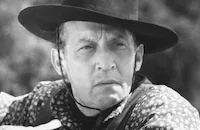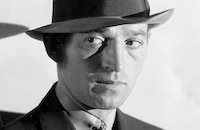Bette Davis' onscreen courtroom drama was also a happy ending to her real-life court battle with Warner Brothers. In 1936, fed up with the mediocre vehicles the studio kept assigning her, Davis refused to do the next film on her schedule. Instead, she accepted an offer to do two films in Europe, and took off for England. Warner Brothers sued to hold Davis to her contract and keep her from making the films in Europe. The studio won the case, but instead of punishing the prodigal daughter, Jack Warner began giving her better roles. Marked Woman was Davis' first post-strike vehicle, and a vast improvement over the films she'd been making.
Still, Bette continued her rebellious ways when she thought it was good for the film. Marked Woman gets its title from the fact that her character, Mary, is beaten and her face cut by the mobster's henchmen - putting his "mark" on her. This had actually happened to one of the prostitutes who testified against Luciano. For a scene in Mary's hospital room, the Warners makeup department applied one tasteful little bandage to Bette's face. During the lunch break, a disgusted Davis drove to her own doctor's office, described the injuries the character was supposed to have suffered, and asked him to bandage her for real. As she drove back onto the lot, the guard at the gate saw her and called studio executive Hal Wallis to report that Bette had been in a terrible accident.
Davis wasn't the only one concerned about authenticity. In a memo responding to Wallis' complaint that a bit player portraying the gangster "Joe" wasn't menacing enough, casting director Max Arnow wrote, "This bit was played by one Hymie Marks, who was formerly a gangster and henchman of Lucky Luciano whom [director Lloyd] Bacon asked to specifically play this one line bit."
Among others in the large cast are Mayo Methot, soon to become the third Mrs. Humphrey Bogart, as the aging hooker Estelle; and newcomer and Bette Davis protÈgÈ Jane Bryan, who would soon retire from the screen to marry businessman Justin Dart. Dart later became an adviser to President Ronald Reagan.
Director: Lloyd Bacon
Producer: Louis F. Edelman, Hal B. Wallis
Screenplay: Robert Rossen, Abem Finkel, Seton I. Miller
Editor: Jack Killifer
Cinematography: George Barnes
Art Direction: Max Parker
Music: Leo F. Forbstein
Principal Cast: Bette Davis (Mary Dwight), Humphrey Bogart (David Graham), Jane Bryan (Betty Strauber), Eduardo Ciannelli (Johnny Vanning), Isabel Jewell (Emmy Lou Egan), Mayo Methot (Estelle Porter), Lola Lane (Gabby Marvin), Rosalind Marquis (Florrie Liggett).
BW-97m. Closed captioning.
By Margarita Landazuri








































